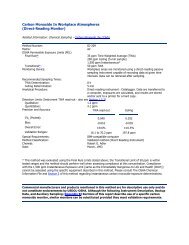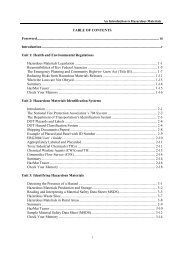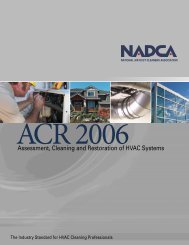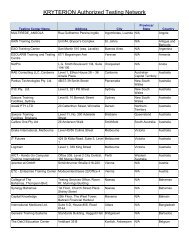Dampness and Mould - WHO guidelines for indoor air quality - PRWeb
Dampness and Mould - WHO guidelines for indoor air quality - PRWeb
Dampness and Mould - WHO guidelines for indoor air quality - PRWeb
You also want an ePaper? Increase the reach of your titles
YUMPU automatically turns print PDFs into web optimized ePapers that Google loves.
2<br />
<strong>WHO</strong> GUIDELINES FOR INDOOR AIR QUALITY: DAMPNESS AND MOULD<br />
evidence regarding the hazards posed by several biological agents that pollute<br />
<strong>indoor</strong> <strong>air</strong>; however, the <strong>WHO</strong> working group convened in October 2006 concluded<br />
that the individual species of microbes <strong>and</strong> other biological agents that<br />
are responsible <strong>for</strong> health effects cannot be identified. This is due to people often<br />
being exposed to multiple agents simultaneously, to complexities in accurate estimation<br />
of exposure <strong>and</strong> to the large numbers of symptoms <strong>and</strong> health outcomes<br />
due to exposure. The exceptions include some common allergies, which can be<br />
attributed to specific agents, such as house dust mites <strong>and</strong> pets.<br />
While quantitative <strong>guidelines</strong> could not be provided <strong>for</strong> the concentrations of<br />
many biological agents, recommendations, guidance or <strong>guidelines</strong> (all referred<br />
to ‘<strong>guidelines</strong>’ in this text) have been <strong>for</strong>mulated to protect health <strong>and</strong> identify<br />
health risks by defining indicators of a safe <strong>indoor</strong> environment. Thus, the <strong>guidelines</strong><br />
define problems <strong>and</strong> the circumstances in which risk is likely to occur but<br />
do not include recommendations on acceptable levels of exposure to biological<br />
agents. The aim of these <strong>guidelines</strong> is to help public health authorities <strong>and</strong> the<br />
general public to identify the hazards <strong>and</strong> reduce the risks. They do not, however,<br />
BOX 1<br />
Definitions of some terms used in the <strong>guidelines</strong><br />
Air-conditioning system: assembly of equipment <strong>for</strong> treating <strong>air</strong> to control simultaneously<br />
its temperature, humidity, cleanliness <strong>and</strong> distribution to meet the requirements of a<br />
conditioned space.<br />
<strong>Dampness</strong>: any visible, measurable or perceived outcome of excess moisture that causes<br />
problems in buildings, such as mould, leaks or material degradation, mould odour or<br />
directly measured excess moisture (in terms of relative humidity or moisture content) or<br />
microbial growth.<br />
Excess moisture: moisture state variable that is higher than a design criterion, usually<br />
represented as moisture content or relative humidity in building material or the <strong>air</strong>. Design<br />
criteria can be simple indicators (e.g. no condensation or relative humidity value) or more<br />
complicated representations that take into account continuous fluctuation of moisture (i.e.<br />
mould growth index).<br />
Moisture: (1) water vapour; (2) water in a medium, such as soil or insulation, but not bulk<br />
water or flowing water.<br />
Moisture problem or damage; water damage: any visible, measurable or perceived<br />
outcome caused by excess moisture indicating <strong>indoor</strong> climate problems or problems of<br />
durability in building assemblies; moisture damage is a particular problem of building<br />
assembly durability; water damage is a moisture problem caused by various leaks of water.<br />
Moisture transport: moisture can be transported in both the vapour <strong>and</strong> the liquid phase<br />
by diffusion, convection, capillary suction, wind pressure <strong>and</strong> gravity (water pressure).<br />
<strong>Mould</strong>: all species of microscopic fungi that grow in the <strong>for</strong>m of multicellular filaments,<br />
called hyphae. In contrast, microscopic fungi that grow as single cells are called yeasts, a<br />
connected network of tubular branching hyphae has multiple, genetically identical nuclei<br />
<strong>and</strong> is considered a single organism, referred to as a colony (Madigan, Martinko, 2005).<br />
Ventilation: process of supplying or removing <strong>air</strong> by natural or mechanical means to or<br />
from any space; the <strong>air</strong> may or may not have been conditioned.






